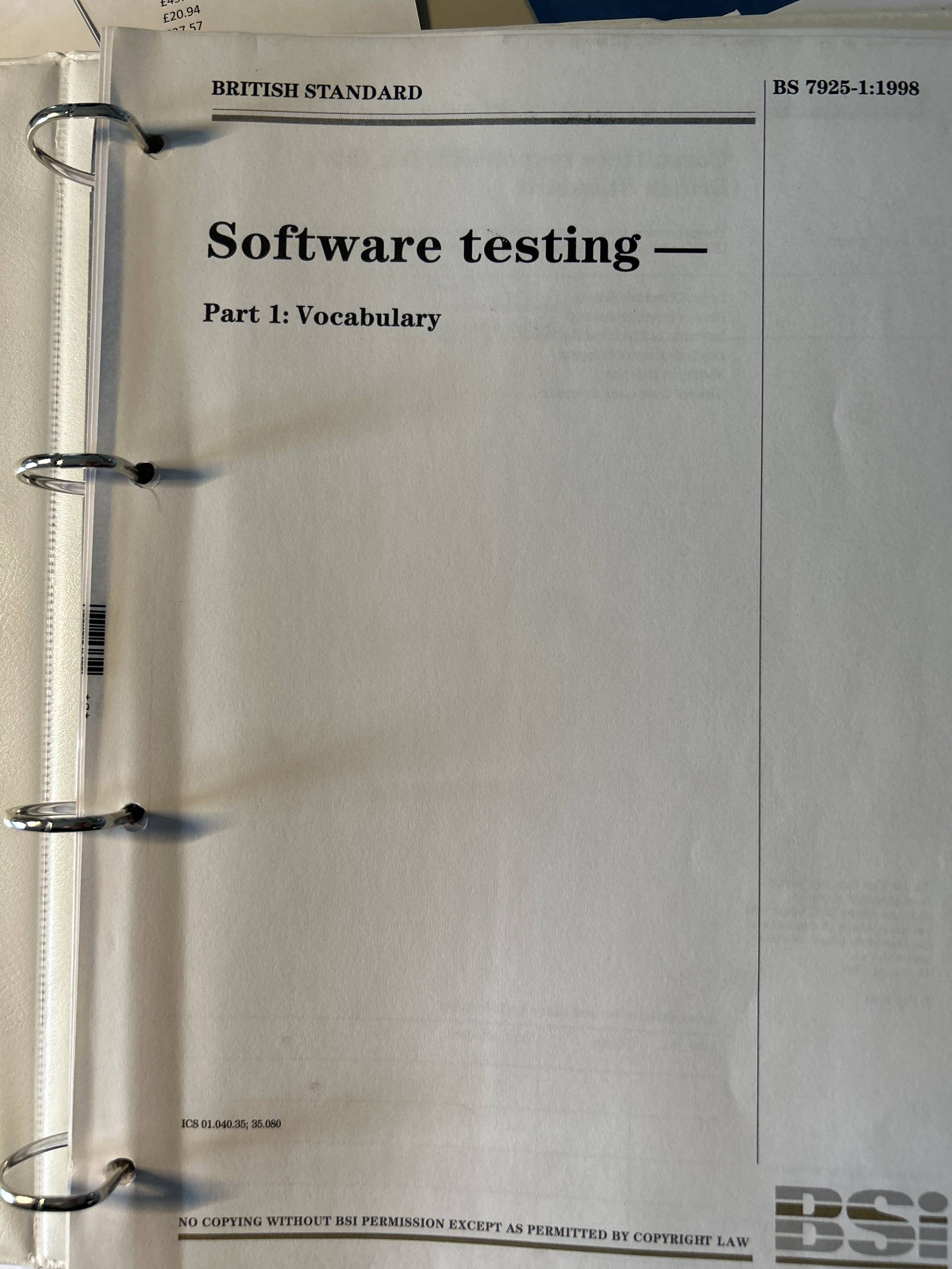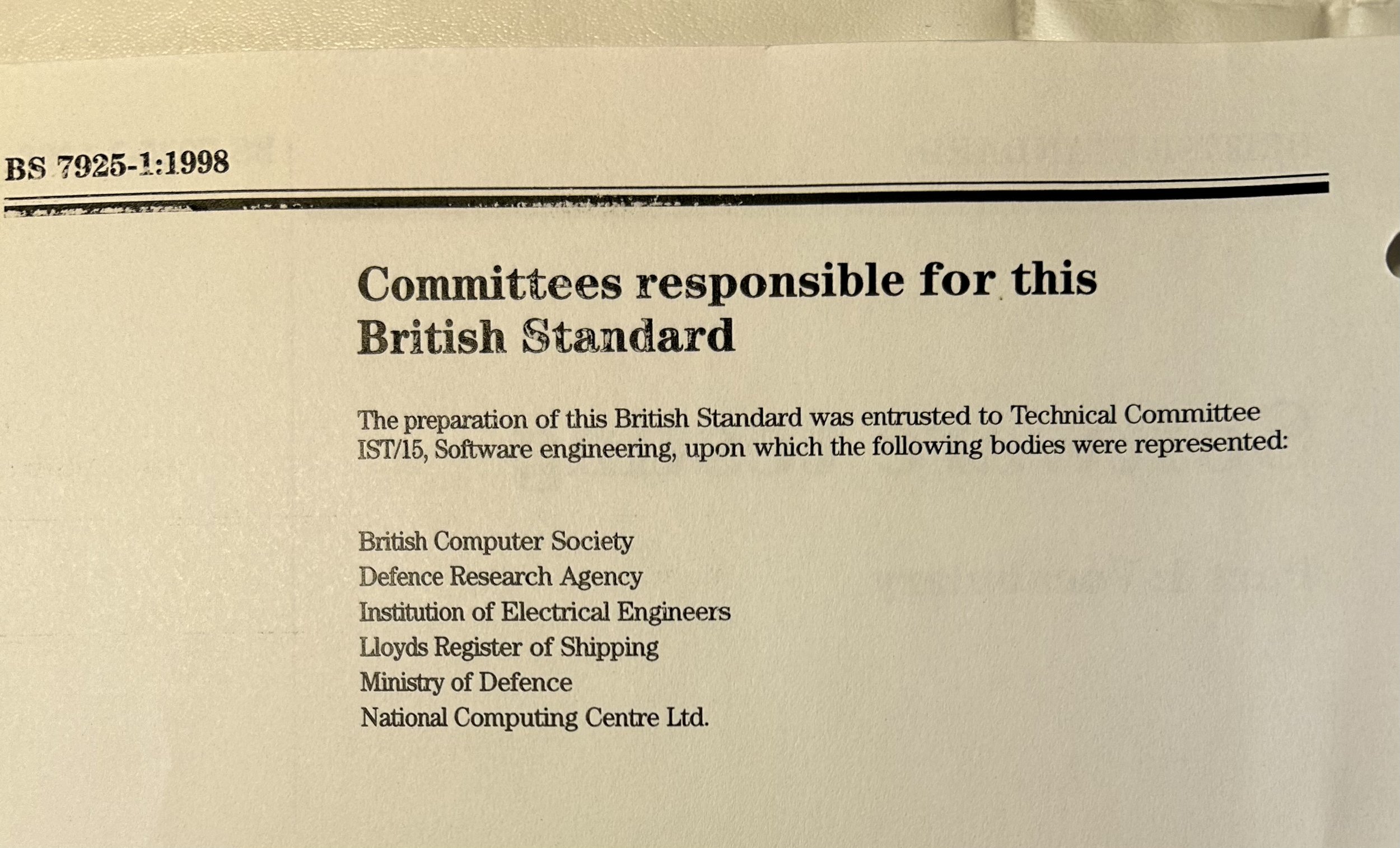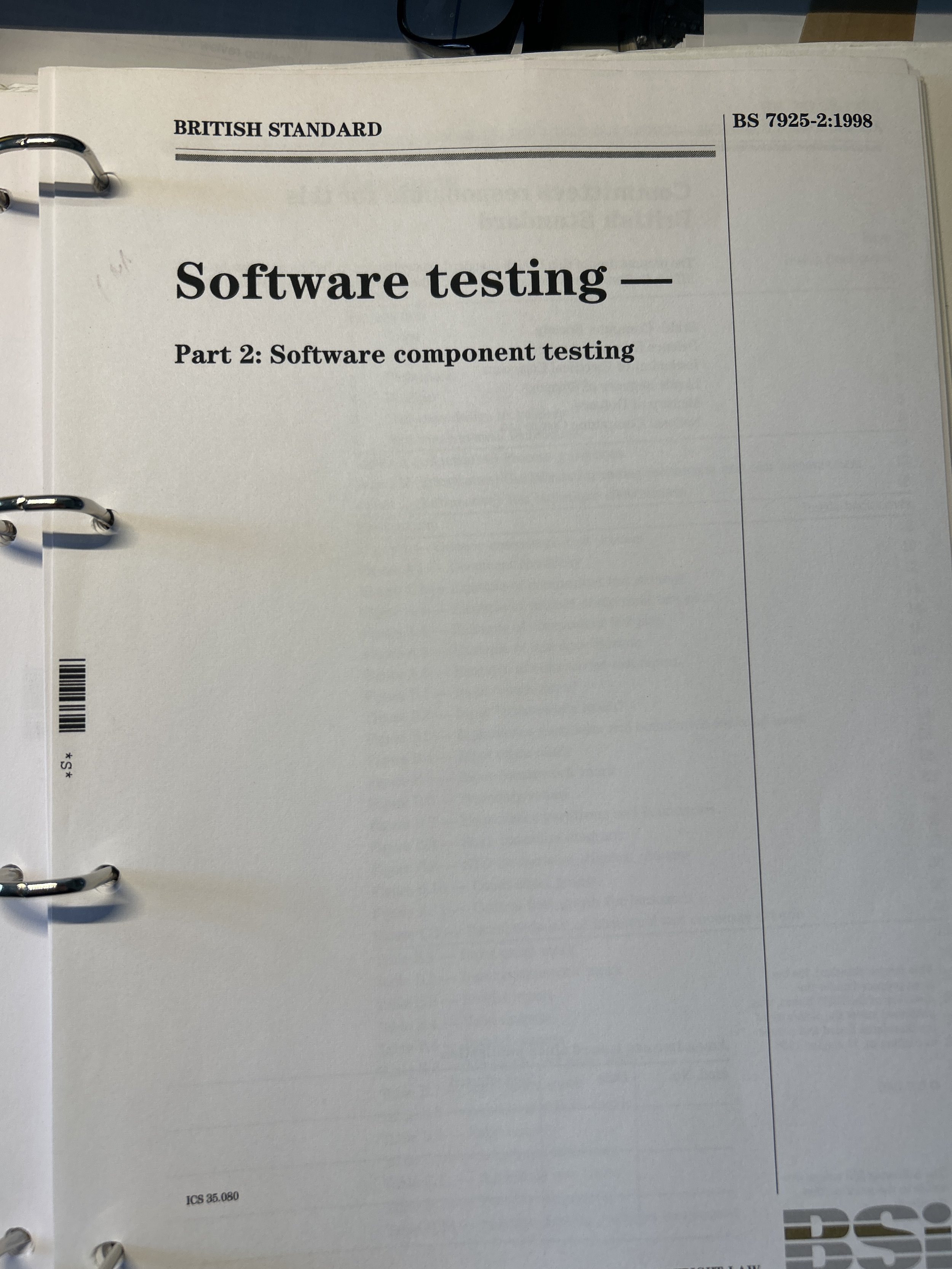BS 7925 Revisited
Introduction
A long time ago in a place far far away ... I got involved with an initiative to create a software testing standard eventually published as British Standard 7925.
You can download the Draft Standard(s) from here.
These are some recollections of the years 1993 to 1998. I make no promise to get any of these memories 100% correct. (I haven't consulted any of the other participants in the story; I am writing this essay on impulse). They are mostly impressions, and impressions can be wrong. But I was there and involved at least.
As the Standard explains, this initiative started in January 1989 with a Standards Working Party (SWP) formed from members of the Specialist Interest Group in Software Testing (SIGIST, now BCS SIGIST). I don't know the detail of what actually happened but, in July 1992, a draft document was produced, and after some use of it in a few places, no one seemed very happy with it.
After a period, some of the members of the SWP decided to have another attempt. There were invites to get others involved through the SIGIST network and newsletter, and I was one of the 'new intake' to the SWP.
A New Start
In January 1993, a reformed SWP re-started from scratch, but retained the existing document as a source – some of it might be reusable, but the scope, overall direction and structure of the document needed a re-think.
PA Consulting generously offered the SWP free use of one of their meeting rooms in a plush office in Victoria, London, and provided nice coffee and generous bowls of fresh fruit, I recall. The number of participants in the group varied over time, averaging 10-12, I guess. Our monthly meetings typically had 8-10 people involved.
My old friend, Stuart Reid of Cranfield University at the time, led the effort – he had experience of working with standards bodies before. Other members (who I would name if I could remember them all) worked for organisations including National Physical Laboratory, Safety-Critical Systems Club, IPL, Praxis. I was a consultant at Systeme Evolutif a UK testing services company – which became Gerrard Consulting some years later. And so on.
I recall I was in a minority – I was one of a small number of consultants working in middle of the road IT at the time, and not safety-critical or high integrity systems. We were sometimes at odds with the other SWP-ers, but we learnt a lot in the meantime. We got on pretty well.
Early Direction
The original goal of the SWP was to come up with consistent, useful definitions of the main test design techniques that had been described in books like Glenford J Myers' Art of Software Testing – 1st Edition and Boris Beizer's Software Test Techniques.
At the time, there were very few books on software testing, although there were academics who had published widely on (mostly) structural test techniques such as statement, branch/decision testing and more stringent code-based approaches, as well as functional techniques such as combinatorial-, logic-, state- and X-Machine-based test design.
The descriptions of these techniques were sometimes a little imprecise and in conflict at times. So our plan was to produce a set of consistent descriptions of these.
From the eventual standard:
“The most important attribute of this Standard is that it must be possible to say whether or not it has been followed in a particular case (i.e. it must be auditable). The Standard therefore also includes the concept of measuring testing which has been done for a component as well as the assessment of whether testing met defined targets.”
Now this might not have been at the forefront of our minds at the start. Surely, the goal of the standard is to improve the testing people do? At any rate, the people who knew about standards got their way.
It seemed obvious that we would have to define some kind of process to give a context to the activity of test design so we decided to look only at component-level testing and leave integration, system and acceptance testing to another standards efforts. We would set the path for the other test phase standards and leave it there. (Yes, we really thought for a while we could standardise ALL testing!)
Some Progress, with Difficulty
So, we limited the scope of the standard to unit, component, program, module, class testing. Of course we had to define what a component was first. Our first challenge. We came up with:
Component: “A minimal software item for which a separate specification is available”
and:
Component testing: “The testing of individual software components. After [IEEE]”
That was kind of easy enough.
After some debate, we settled on a structure for the standard. We would define a Component Test Process, introduce each functional and structural test technique in two dimensions: as a technique for test design and as a technique for measurement (i.e. coverage).
All we had to do now was write the content, didn't we?
Difficulties and the Glossary
I think at that point, all our work was still ahead of us. We made some progress on content but got into long and sometimes heated debates. The points of dispute were often minor, pedantic details. These were important, but in principle, should have been easy to resolve. But no. it seemed that, of the seven or eight people in the room, two or three were disgruntled most of the time. We took turns to compromise and be annoyed, I guess.
From my perspective, I thought mostly, we were arguing over differing interpretations of terms and concepts. We lacked an agreed set of definitions and that was a problem, for sure.
In a lull in proceedings, I made a proposal. I would take the existing content, import it into a MS Access database, write a little code, and scan it for all the one, two, three and four word phrases. I would pick out those phrases that looked like they needed a definition and present the list at the next meeting. It took me about a day to do this. There were about 10,000 phrases in our text. I picked out 200 or so to define, presented them and the group seemed content to agree definitions as and when the conversation used a term without one. This seemed to defuse the situation and we made good progress without the arguing.
This was probably my most significant contribution. The resulting Glossary became BS 7925-1 (small fanfare please).
Process, Damned Process
The process was not so hotly debated, but why damned? Some of the group thought it would be uncontroversial to define a process for Component Testing. But some of us (the middle-of-the-road brigade) had fears that a process, no matter how gently defined and proposed, could trigger negative responses from practitioners to reject the standard out of hand.
We adopted a minimalist approach – there is little detail in the process section except a sequential series of activities with multiple feedback loops. There is no mention of writing code or amending code to fix bugs. It just explains the sequence and possible cycles of the five test activities.
It caused upset all the same – you can't please all the people all the time, and so on. But see my views on it later.
Finishing the Drafts
I have to say, once the structure and scope of the of the Standard was defined, and the Glossary definition process underway, I stepped back somewhat. I'm not a good completer-finisher. I reviewed content but didn't add a lot of material to the final draft. The group did well to crank out a lot of the detail and iron out the wrinkles.
Submission to the British Standards Institute
Stuart managed the transition from our SWP to the standards body. Trusting that standards can be expensive to purchase, once published, we created a final draft and made it publicly available for free download. That final draft went to the BSI.
The SWP wrote the standard. The BSI appointed a committee (IST/15) to review and accept it.
You can see the involved parties are the sort of august organisations who might implement a Component Test Standard.
Legacy
It's just over 25 years since the standard was published on 15 August, 1998.
In April 2001, I set up a website (http://testingstandards.co.uk) which hosted downloadable copies of the (SWP Draft) standards. The site was managed by some colleagues from the SWP and others interested in testing standards at the time. Some progress was made (in some non-functional testing) but that work kind of fizzled out after a few years. I keep the website running for sentimental reasons, I suppose. It is neglected, out of date and most of the external links don't work. but the download links above do work and will continue to do so.
BS 7925-1 and -2 have been absorbed into/replaced by ISO 29119. The more recent standard 29119 caused quite a stir and there was an organised resistance to it. I fully agree that standards should be freely available but the response to it from people who are not interested or believe in standards was rather extreme and often very unpleasant.
Let standards be, I say. If people who see value in them want to use them, let them do so. Free country and all that. I don't see value in large overarching standards myself, I must say, but I don't see them as the work of the devil.
Anyway.
BS 7925 – a Retrospective
BS 7925-1 – “Vocabulary” - provided a glossary of some 216 testing terms used in the Component Testing Standard.
Skimming the glossary now, I think the majority of definitions are not so bad. Of course, they don't mention technology and some terms might benefit from a bit of refinement, but they are at least (and in contrast to other glossaries) consistent.
BS 7925-2 – “Component Testing” - provided a process and definitions of the test design techniques.
Component Test process
The final draft, produced by the SWP and the eventual standard contained some guidelines for the process that place it squarely in the context of a waterfall or staged development approach. At the time Extreme Programming (1999) and the Agile Manifesto (2001) lay in the future.
Does this mean the process was unusable in a modern context? Read the process definition a little more closely and I think it could fit a modern approach quite well.
Forget the 'document this' and 'document that' statements in the description. A company wide component test strategy is nonsense for an agile team with two developers. But shouldn't the devs agree some ground rules for testing before they commit to TDD or a Test-First approach? These and other statements of intent and convention could easily be captured in some comments in your test code.
Kent Beck (who wrote the seminal book on TDD) admits he didn't invent the test-first approach but discovered it in an ancient programming book in the late 1990s. Michael Bolton helpfully provides an example – perhaps the first(?) – description of Test-First as an approach here.
We designed the component test process to assume a test-first approach was in place and it is an iterative process too – the feedback loops allow for both. Test-First might mean writing the entirety of a test plan before writing the entirety of the component code. But it could just as easily refer to a single check exercising the next line of code to be added.
So I would argue that with very little compromise, it supports TDD and automated testing. Not that TDD is regarded as a 'complete' component test approach. Rather, that the TDD method could be used to help to achieve required levels of functional and structural coverage, using good tools (such as a unit test framework and code coverage analyser).
I also appreciate that for many developers it doesn't add anything to a process they might already know by heart.
Test Techniques
Regarding the technique definitions, pretty much they stand as a concise, and coherent set of descriptions. Annex B provides some good worked examples of the techniques in use. Of course, there are deeper/academic treatments of some, perhaps all of these techniques. For example, Kaner, Radmanabhan and Hoffman wrote the 470 page “Domain Testing Workbook” – a generalisation of the equivalence partitioning and boundary value techniques in 2003.
If you want a description of techniques that presents them in a way that emphasises their similarity as examples of the concept of model-based test design and measurement, you would do well to find a better summary.
In Conclusion
This blog has been a trip down a (fallible) memory lane describing events that occurred from 34 to 25 years ago.
I am not suggesting the standard be revived, reinstated, brought up to date, or ever used. But I wanted to emphasise two things in this essay:
The BS 7925 Standards effort was substantial – overall, it took nine years from idea to completion. The second, more productive phase, took about 4 years. I am guessing that effort was between 300 and 500 man days for the SWP alone. People gave their time in good faith and for no reward.
The challenges of programming and testing have not changed that much. The thinking, debate, ideals aspired to and compromises made in the late 1990s to create a component test standard are much the same.
Even so, do not think that creating a workable Component Test Standard for modern environments would be a simple task.
#teststandard #testingstandard





